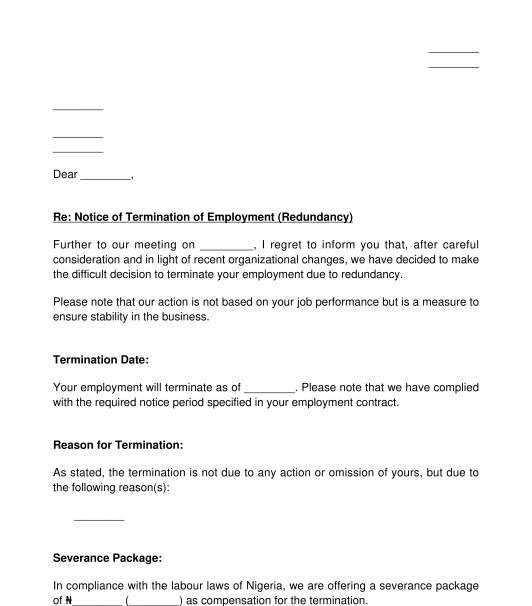 07/04/2025
07/04/2025

Answer a few questions and your document is created automatically.

Your document is ready! You will receive it in Word and PDF formats. You will be able to modify it.

 07/04/2025
07/04/2025
 Word and PDF
Word and PDF
 1 page
1 page



This letter is used when an employer wants to terminate or otherwise end the employee's employment due to redundancy.
Termination due to redundancy is a process where an employer stops a particular job or reduces the workforce due to factors such as mergers or restructuring, technological changes, economic downturns, or shifts in business priorities.
This type of termination is different from a dismissal or termination due to an employee's performance or misconduct. If the employer is terminating the employment for reasons relating to the employee's performance or misconduct, use the Employment Termination Letter.
In the event of redundancy, the employee might receive a lump sum payment for redundancy. In the face of redundancy, the law requires the following:
Note that under the law, there is no mandatory provision for severance pay. Nevertheless, it is commonly considered best practice to offer severance pay as a means of compensating employees for the premature conclusion of their employment.
Despite this, the Employment Contract typically outlines specific severance pay terms, and if so, the employer is obliged to furnish the agreed-upon severance compensation.
This document can be used by any employer that wishes to terminate the employment of their employee due to redundancy.
This document requires the following information: the names and addresses of the employer and employee, the reason(s) for the termination, the severance pay, and other benefits (if applicable).
After completing this document, the employer should print and sign two copies of this document. If the employer is a company or any other organization, an authorized representative (a person who is authorized to send letters of this nature, usually the human resources officer) should sign the letter on behalf of the employer.
After signing, the employer should send the two copies to the employee. Upon receipt of the documents, the employee should keep one document and sign the other document as an acknowledgement of receipt. The signature could read: "Received by me, [name] [signature]".
The employer should keep the acknowledgment copy for their records.
The following laws apply to this document:
You fill out a form. The document is created before your eyes as you respond to the questions.
At the end, you receive it in Word and PDF formats. You can modify it and reuse it.
Country: Nigeria